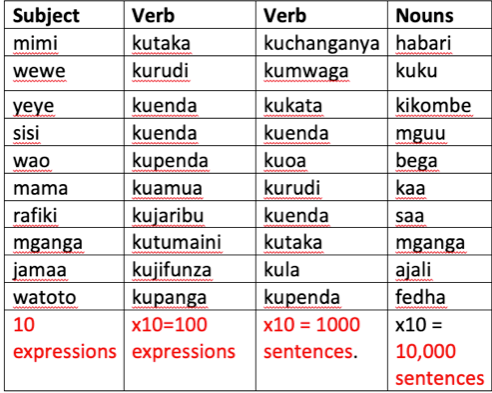COMBINATORICS-THE LANGUAGE GENERATOR!
- Jordan Stackhouse

- Jun 19, 2023
- 4 min read

Have you ever counted the ideas that Gene Roddenberry portrayed in Star Trek that have come, more or less, to fruition? Go ahead and type “list of things that Gene Roddenberry predicted would happen” into Chat GPT and see what happens😄. One cool techy thing he portrayed was a Universal Translator which could enable seamless communication between characters in the show who spoke different languages. Today, while far from perfect, the technology is, well, amazing! Ruth and I are learning Hindi and yes, Google Translate is not super reliable, but it does really help and we are so grateful for it!
One of the methods we present in our dynamic Language Instructor Certification Course is called Linguistic Multiplication. The example we present of this concept is called a “Language Generator.” With this example we demonstrate the link between language learning and the science of combinatorics with its underlying principles of permutations and combinations. We are presently doing a deep dive into its potential and are delighted to show what our research and field testing have revealed thus far.

First of all, let me give you an example of the theory behind a language generator, and then we will discuss what we have deduced are its limitations and practical potential. Here is an example of a language generator for Swahili. It includes 10 words for four parts of speech found in simple sentences- Subject, Verb, Infinitive Verb and an Object or Noun. The math in red shows that by combining the different words progressively amongst each column, one can theoretically say 10,000 things with just 40 words.

Here is a generator that I am working on to learn my first 100 words in Hindi. For the sake of gathering some empirical research, I referenced the Oxford 3000 list of most frequently used words and chose the first 10 words from 10 different parts of speech that can make up a sentence rather than choosing vocabulary from a specific theme.
Okay, with this accomplished, one can immediately see the limitations of this table. For example:
This table is arranged in the grammatical syntax of English which is Subject -Verb-Object, whereas Hindi syntax is Subject-Object-Verb, so after determining the Hindi translation you have to rearrange the words in Hindi syntax. I tried to moved the columns into Hindi syntax first but found that I simply could not make up any phrases to learn unless I mentally rearranged everything to English syntax first.
Verb conjugation and a whole world of hurting prepositions are missing.
Many of the combinations hold little practical value and therefore do not benefit from the Self-Referencing Effect. (See our blog post here) To improve this, choose frequently used words according to common themes. For example, shopping for food or clothes, travel or something directly related to employment.
Despite the limitations, there is still much practical value in utilizing a language table, or as we say, a language generator such as this one. Using the Hindi generator above as an example, here are some benefits of preparing such the table:
You have in one place the material for about 10 language lessons with approximately 10 new words being taught in each new class.
As you prepare your lesson plans you can, in your word processing app, keep track of the vocabulary you have taught. In this case I highlight the vocabulary taught/learned in blue.
As a teacher you can combine the vocabulary and teach it in different combinations in order to help your students become adept at manipulating the language in an authentic way.
While you may not use all of the words in a given table, you can include all of them in flashcards to help your students build a base of vocabulary which can be drawn upon later in future classes.
In conclusion, a “language generator”, as we call it, presents the mathematical combinations of vocabulary but it does not, in itself, cause the learner to automatically generate responses in the target language. The learner must still put the time and effort into practising the target language systematically and frequently. What it does do is give the teacher or the self-learner the parameters for progressively learning a language and it presents a visual reminder of what our marvellous brain is actively doing behind the scenes as it processes the vocabulary learned and searches for ways to combine it in thousands of ways.
Check out a recording our a recent class where we taught this method here:
There is no magic bullet for learning a language, however, when you take our dynamic Language Instructor Certification Course, you learn how the brain wants to learn anything-especially languages! We are so happy to now offer the option of taking our course in Modular form. Consisting of 7 or 8 sessions, you can choose the time most convenient for you to attend the online classes. Come with a friend and you will get CAD $50 off each! This course is a must for those desiring to support themselves by teaching English, IELTS or for those who are self-learning any language. We would be delighted to have you join us soon!







Comments